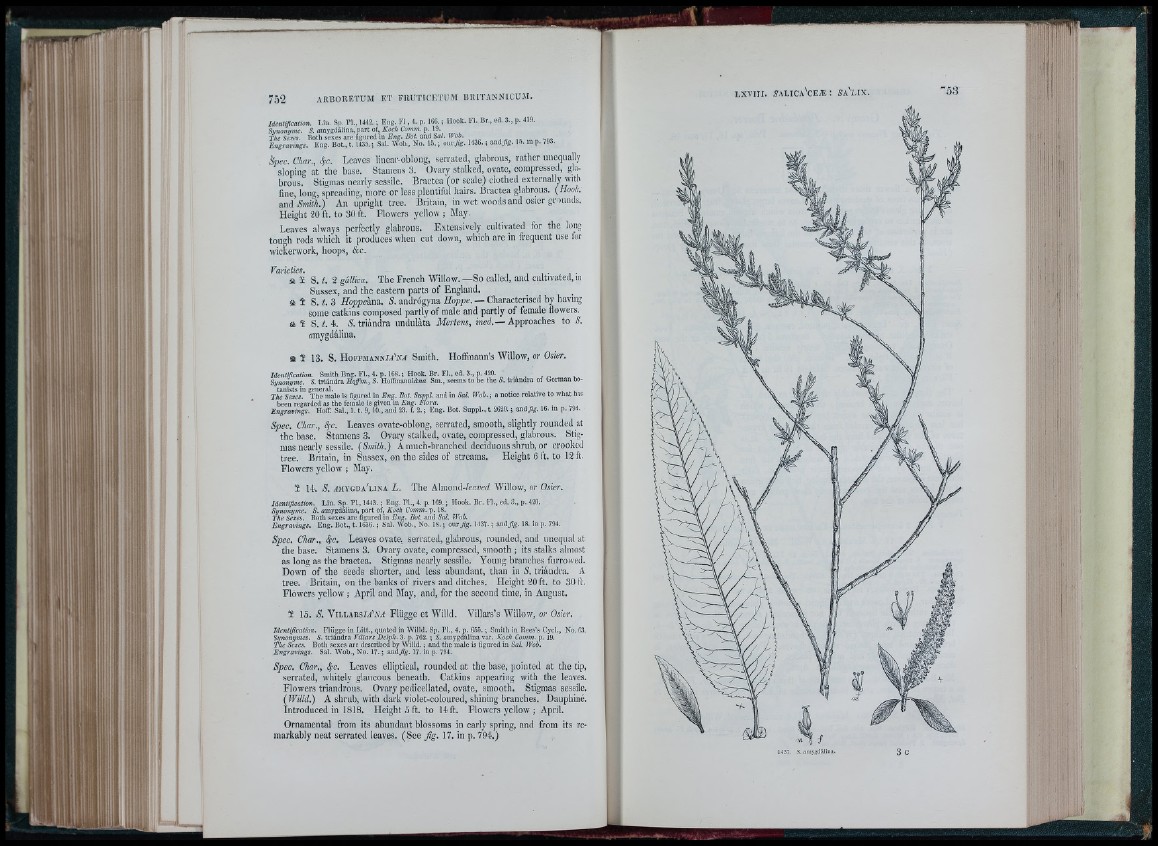
Pl., 1442. i Eng. n , 4. p. 1G6. ; Hook. Fl. B r, ed. 3., p. 419.
Identification.
g s r '
irt of, Koch Comm. p. 19.
■ in Eng. Bot. and Sal. Wob.
Sal. \fo b ,, No. 15.} o u r /g . 1436. ; a n d /g . 15. in p. 793.
Spec. Char., 4c. Leaves linear-oblong, serrated, glabrous, rather unequally
sloping at the base. Stamens .3. Ovary stalked, ovate, compressed, glabrous.
Stigmas nearly sessile. Bractea (or scale) clothed externally with
fine, long, spreading, more or less plentiful hairs. Bractea glabrous. {H o o k ,
awà Smith.) An upright tree. Britain, in wet woods and osier grounds.
Height 20 ft. to 30 ft. Flowers yellow ; May.
Leaves always perfectly glabrous. .Extensively cultivated for the long
tough rods which it produces when cut down, which are in frequent use for
wickerwork, hoops, &c.
Varieties. , , . , .
âfe Ï S. i. 2 gallica. T h e French Willow.—So called, and cultivated, in
Sussex, and the eastern parts of England,
äfe ¥ S. i. 3 Hoppehxa. S. androgyna Hoppe. — Characterised by having
some catkins composed partly of male and partly of female flowers.
Sfe ¥ S. i. 4. ¿.triàndra undulàta Mertens, ined.— Approaches to S.
amygdalina.
Sfe ¥ 13. S. HoFFMANN/.4'N.i Smith. Hoffmann’s Willow, or Osier.
Identification. Smith Eng. Fl., 4. p. 168. ; Hook. Br. Fl., ed. 3., p. 420. ^ ^ ^ r ,
Synonyme. S. triandra Hqff'm., S. Hoffmanniâna Sm., seems to be the S. triàndra of German bo-
TAe'srxes." ^I'he male is figured in Eng. Bot. Suppl. and in Sal. Wob. ; a notice relative to what has
been regarded as the female is given in Dng. Horn.
Engravmgs. Hoff. Sal., 1. t. 9, 10., and 23. f. 2. ; Eng. Bot. Suppl., t. 2620. j a n d /g . 16, in p. 794.
Spec. Char., 4c. Leaves ovate-oblong, serrated, smooth, slightly rounded at
the base. Stamens 3. Ovary stalked, ovate, compressed, glabrous. Stigmas
nearly sessile. (Smith.) A much-branched deciduous shrub, or crooked
tree. Britain, in Sussex, on the sides of streams. Height 6 ft. to 12 ft.
Flowers yellow ; May.
¥ 14. S. .4mygda'lina L . The Almond-Zcrtwri Willow, or Osier.
Identification. Lin. Sp. P l , 1443. ; Eng. Fl., 4. p. 169.5 Hook. Br. FL, ed. 3., p. 420.
Synonyme. S. «mygdàlina, part of, Koch Comm. p. 18.
The Sexes. Both sexes are figured in Eng. Bot. and Sal. Wob.
Engravings. Eng. Bot., t. 1636. ; Sal. Wob., No. 18. j o u r /g . M37. ; a n d /g . 18. in p. 794.
Spec. Char., 4c- Leaves ovate, serrated, glabrous, rounded, and unequal at
the base. Stamens 3. Ovary ovate, compressed, smooth ; its stalks almost
as long as the bractea. Stigmas nearly sessile. Young branches furrowed.
Down of the seeds shorter, and less abundant, than in S. triandra. A
tree. Britain, on the banks of rivers and ditches. Height 20 ft. to 30 fc.
Flowers yellow ; April and May, and, for the second time, in August.
¥ 15. S. Villarsja\v.4 Flügge et Willd. Villars’s Willow, or Osier.
Identification. Flügge in Litt., quoted in Willd. Sp. PL, 4. p. 655. ; Smith in Rees’s Cycl., No. 03.
Synonymes. S. triandra Villars Delph. 3. p. 762. ; S. amygdâlina var. Koch Comm. p. 19.
The Sexes. Both sexes are described by Willd. ; and the male is figured in Sal. Wob.
Engravings. Sal. Wob., No. 17. ; a n d /g . 17- in p. 794.
Spec. Char., 4c. Leaves elliptical, rounded at the base, pointed at the tip,
serrated, whitely glaucous beneath. Catkins appearing with the leaves.
Flowers triandrous. Ovary pedicellated, ovate, smooth. Stigmas sessile.
(Willd.) A shrub, with dark violet-coloured, shining branches. Dauphiné.
Introducedin 1818. Height 5 ft. to 14ft. Flowers yellow ; April.
Ornamental from its abundant blossoms in early spring, and from its remarkably
neat serrated leaves. (See ß g . 17. in p. 794.)
M.17. .S. aniysilMiiia.
£
II :<■
i r
i ? ij: '.j :
» J
è ) : ,! T I